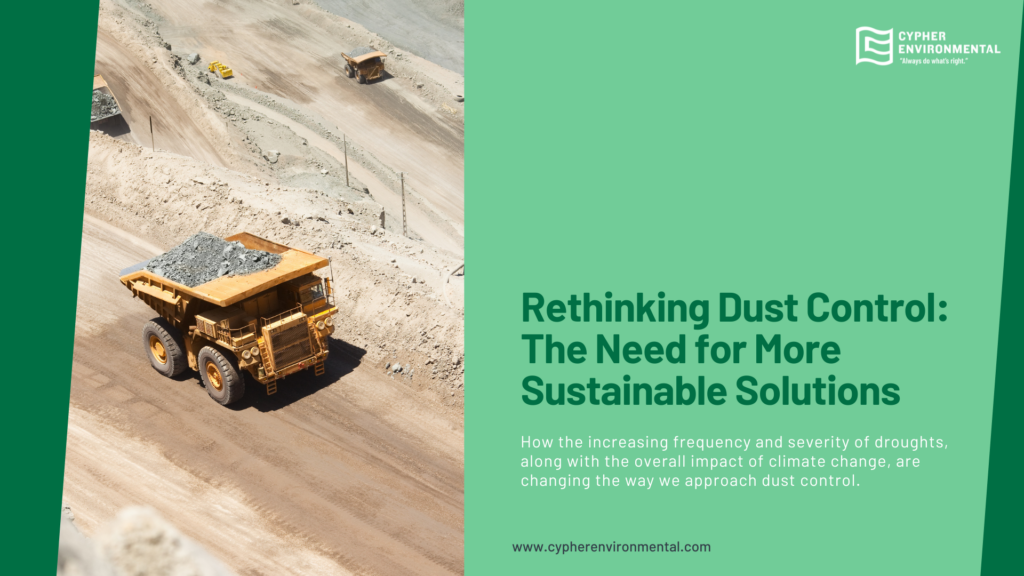
The issue of drought is becoming increasingly dire. According to the United Nations Convention to Combat Desertification, 1.84 billion people across 101 countries face drought conditions, with 4.7% of them in conditions that are considered severe or extreme drought[1]. The World Health Organization (WHO) warns that by the year 2030, 700 million people could be at risk of displacement due to drought-related conditions[2].
This stark reality demands immediate and decisive action.
If your business operations aren’t evolving to reduce water consumption, you are contributing to this growing global crisis.
The Environmental Cost of Water in Dust Control
Traditional dust abatement products and methods rely heavily on water to dampen roads and surfaces. This is not only wasteful but also environmentally unsustainable. Using vast amounts of water to suppress dust is a short-term solution that does not address the root problem. Additionally, frequent use of water trucks, especially those with diesel engines, significantly increases greenhouse gas emissions, contributing to climate change.
Other methods of dust control call for the use of harmful chlorides such as sodium chloride (NaCl) and calcium chloride (CaCl2). These chemicals are highly corrosive and toxic to the environment – causing harm to vegetation, wildlife and whole ecosystems. Runoff can also seep into our water sources, altering the chemical balance required to sustain aquatic life.
On mining sites, the environmental impact is even greater due to the scale of their operations. Not only does this approach waste precious water resources, but it also leads to excessive fuel consumption, exacerbating the environmental footprint of mining operations.
The Financial Impracticality of Water-Based Dust Control
Even when water is inexpensive to purchase, the continuous costs of watering roads – the cost of hauling water, fuel, operating a fleet of water trucks, interruptions to your operation – can all add up overtime. As industries face increasing pressure to reduce their environmental impact, it is clear that choosing these outdated methods just because “that’s how they have always been done” does not make sense anymore. It is time to evolve, or get left behind in a cloud of dust!
The Mining Industry’s Shift Toward Sustainable Practices
The mining industry, recognizing the importance of water stewardship and environmental sustainability has been gradually shifting toward more sustainable and environmentally responsible practices. Initiatives like the International Council on Mining and Metals (ICMM) help prioritize the adoption of sustainable practices that minimize environmental impact.
In light of our current situation, the real pressing questions is – what steps have you taken to evolve your operations and address the challenges posed by our changing climate?
Finding Sustainable Dust Abatement Products and Methods
Cypher Environmental’s DUST/BLOKR line of products are sustainable alternative dust abatement products for haul and access roads. The proprietary formula forms a durable, dust-free barrier that is capable of reducing airborne dust by 90%+. In the case of one mining client, after implementing a combination of DUST/BLOKR, the mining operation was able to reduce its water usage by over 85%[3]! Mining operations across the globe, including those in challenging environments like the Andes and Guinea, have reported significant improvements after adopting DUST/BLOKR.
Benefits of DUST/BLOKR®
-
85%+ Reduction in Water Usage: Conserve water resources while contributing to broader environmental sustainability efforts.
-
Significant Financial Savings: Lower water procurement and operational costs, enhancing your bottom line.
-
Environmentally Safe and Effective: DUST/BLOKR is 100% environmentally safe, offering long-lasting and reliable dust control that perform well in both wet and dry conditions. DUST/BLOKR treated roads have also shown positive results on both brake tests and skid resistance tests.
-
Easy Application: DUST/BLOKR is applied using standard equipment and techniques. The product can easily be adopted by any customers who have used a water truck for dust control applications.
-
Logistical Advantages: DUST/BLOKR is shipped in a highly concentrated form and mixed with several parts water prior to application, creating a solution that is cost-effective enough to ship globally or to remote locations while reducing carbon emissions.
-
Versatility of Use: Due to its non-toxic and non-corrosive nature, DUST/BLOKR can be applied to environmentally-sensitive areas as well as on airfields, air strips and around aircraft materials. In fact, DUST/BLOKR has been approved by Transport Canada for use at Canada’s airports and aerodromes. DUST/BLOKR has also been confirmed to meet Boeing Specifications BSS7432 (D6-17487) Evaluation of Aircraft Maintenance Materials – Exterior and General Cleaners and Liquid Waxes, Polishes and Polishing Compounds.
View this post on Instagram
Why now?
Whether it is DUST/BLOKR or other alternative dust abatement products, the need to move away from the harmful use of chlorides is undeniable. By adopting environmentally responsible products such as DUST/BLOKR, you not only enhance operational efficiency and reduce unnecessary expenses but also take a crucial step toward a more sustainable future.
Further Reading:
-
United Nations Convention to Combat Desertification: UNCCD Data Dashboard
-
Cypher Environmental: The Cost of Water in Mining, March 5, 2024
- World Conservation Day: Why This Year, We are Focusing on Water Conservation, July 28, 2024

